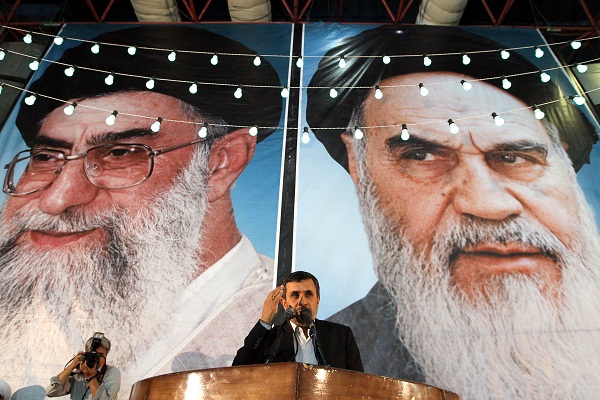There is a Persian proverb which states that ‘books are a man’s best friend.’ Persian literature from the kings of antiquity to the last Shah of the Peacock Throne has, for the most part, been dominated by its proverbial male companion. When presented with today’s Islamic Republic, an unfamiliar Western reader can easily believe that a female literary voice cannot possibly exist underneath the seemingly anonymising chador, the Islamic female dress most closely associated with Iran. Instead, all that would appear to emanate from Iran is a male voice: Ahmadinejad defending arms programs; the Mullahs dictating morality; Khomeini, father of the nation, ever-present from beyond the grave, still influencing the country he theologically revolutionised thirty-three years ago this winter.
Few can claim to be the first novelist of any given language, culture and gender, yet when Simin Daneshvar died earlier this year, her obituaries teemed with praise emphasising her status as the first published female novelist of the Iranian canon. Born in 1921 into a middle-class Shirazi family, Daneshvar was educated at her local English missionary school – Southern Iran at the time fell within the British colonial sphere of influence – before moving to the capital with her family. After her father’s death she began working at Radio Tehran and the newspaper Iran to support her family, facilitated by the liberalising social conditions encouraged under the reformist Pahlavi dynasty. Around this time she started to write fiction and resumed her studies at the University of Tehran, eventually receiving a doctorate in Persian Literature and marrying fellow intellectual and writer, Jalal Al-e Ahmad. She was to write later that she married only under one condition: ‘I will remain Simin Daneshvar, not being identified as Mrs Al-e Ahmad, and thus would keep my freedom.’ Her marital life was quickly interrupted when she travelled to the country which was to become the diabolic enemy of her homeland, working as a Fulbright Fellow at Stanford University for two years where she continued her pursuits in fiction. Following her return to Iran she obtained a post at the University of Tehran as an associate professor in Art History, prevented from obtaining a full professorship due to intervention by the Shah’s notorious secret police SAVAK and the ever-present threat of Evin Prison (Tehran’s answer to the Bastille), which still menaces dissidents to this day. Despite this, she steadily continued her writing and enjoyed the stability of her marital life, as discontent with the Shah’s regime grew around her and the future of Iran seemed increasingly unclear. However her personal life soon met with turmoil with her husband’s death in 1969, months before her chef-d’oeuvre Savashun (also translated as A Persian Requiem) was published.
The novel, told from a female perspective, recounts the story of a middle-class family in Shiraz under foreign occupation in World War Two. It portrays a microcosm of the Iran in which Daneshvar grew up; occupying forces come into turbulent conflict with tribal politics and the innumerable social factions of which Iranian society is composed. It sets a thematic framework to which Daneshvar would continuously return: the point at which the role of women, politics – both local and international – and family collide, contextualised within the complexities of twentieth century Iranian history. It was received warmly by critics but also proved popular with a Persian readership, encouraging Daneshvar to write several collections of short stories, as well as a trilogy chronicling the nation before, during and after the Islamic Revolution.
Her work has been translated into seventeen languages and would appear tailor-made for such international exposure. It allows the Western reader with mediatised images of a Republic full of chanting fanatics and martyrs to gain insight into the Iranian home and family, and perhaps rather uncomfortably, into the role Western powers played in shaping this much maligned and much misunderstood nation. It shows to the generation of Khomeini’s children living abroad in Europe and North America an image of what life was like before the Revolution, a story only otherwise heard from parents and grandparents who emigrated from Iran to escape the emerging theocracy which the Grand Ayatollah was seeking to create. As a firm favourite on bookshelves from the Caspian Sea to the Straits of Hormuz, it serves as a reminder to Iranians of their troubled history, their cultural traditions and the need never to lose hope.
In 1994 Iranian writers came together to declare their united position on writing and free speech, stating: ‘our collective presence is the guarantee of our individual independence.’ Daneshvar began her writing career forty years earlier under the pen-name ‘The Unknown Shirazi’, yet by the end of her life it was her unique position as a woman writing narrative fiction in a male dominated literary scene obsessed with poetry, which ensured that it was her individual presence which encouraged female creative independence in Iran. As a paradigm of the Middle Eastern ‘writer engagé’, Daneshvar’s life and work come together in a social and artistic fusion few can emulate; she wrote in later life: ‘As an Iranian I have suffered and I have been patient, but I endure and have great hope and faith in the future.’
Stephen McEwen is a freelance writer in London and a Persophile who worked on the Asia House Festival of Asian Literature for two years.






Comments